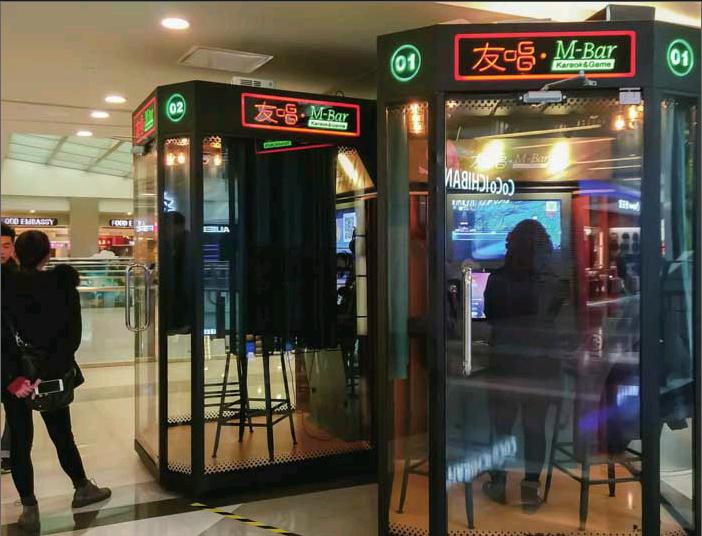Small Booth,Big Trend
2017-06-15ByHouWeili
By+Hou+Weili

One afternoon, while enjoying a leisurely stroll in her favorite shopping center in Beijing, something caught Wang Wens eye. The 25-year-old was attracted by a row of glass boxes somewhat resembling telephone booths. Upon further inspection, she realized they were karaoke booths. It was too much of a temptation to have fun and play the pop star for a few songs, so she decided to give it a try.
After queuing for nearly 30 minutes, she and her friend fi nally got to open the door of one of the booths, where they were greeted by a pair of display screens, barstools, headphones and microphones in a small but cozy 2-square-meter space, just enough to fi t two karaoke fans.
Scanning the QR code on the screen with her smartphone, she connected to the system and purchased a 15-minute package of singing and fun. The amateur singer then began her performance, singing happily just as in a classic karaoke bar, also known as KTV in China.
“Its fun. I didnt have to invite several friends and book a KTV room in advance; I can just have fun singing even if I have just 10 minutes of free time,” Wang said.
Since 2016, such KTV booths have been mushrooming across China with over 10,000 sets installed in shopping malls in the last six months. According to Luo Anwu, founder of M-Bar, one of the most prolifi c brands of KTV booths in China, his glass kiosks have already appeared in 135 cities across 29 provinces, municipalities and autonomous regions.
Allowing KTV enthusiasts to record and share their performance with their smartphone, such mini karaoke parlors target mostly young people of the post-80s and 90s generation, whose free time is fragmented and for who in sharing moments of their life on social media has become a lifestyle.
A more flexible option
For Wei Pengju, Director of the Creative Culture Research Institute at Beijings Central University of Finance and Economics, this emerging recreation experience is the sign of a new trend in which young people prefer to consume entertainment and cultural products in a more flexible way. “It is the result of physical stores integrating with the Internet,” he explained.
“The KTV booth is a real Internet product, for it introduces the Internets features of sharing and entertaining to offline KTV clubs. Through its intelligent control system, customers can remotely adjust the lighting, the playing system, the air conditioning and Wi-Fi connection inside the booth, allowing them to have complete control over their experience,” Luo said.
Such an intelligent system also means service personnel are no longer necessary. According to Kuang Shi, a senior analyst on Internet communication businesses at BOC International Ltd., a wholly owned subsidiary of Bank of China, the price of such KTV booths goes from 16,000 to 28,000 yuan($2,316-$4,053), in addition to a monthly rent of 900-2,000 yuan ($130-$289) paid to shopping malls. The monthly cost of maintaining the equipment is low, at around 100 yuan ($14.5), according to Luo.
User fees are also more flexible than traditional karaoke bars. Clients can choose to pay for either 15 minutes or three songs at around 20 yuan ($2.9). According to Wei, such booths are also an excellent media source, which means additional revenue can be generated through advertisement.
According to market research conducted by Kuang, the current daily revenue generated by one booth can reach around 400 yuan ($57.9).
Shaking the market
In stark contrast, the traditional karaoke market has been looking bleak in the last few years. Party World KTV, which used to be the champion in this sector, closed three of its four stores in Beijing in early 2015. In the same year, Wanda Group announced the shutdown of its entire KTV parlor business.
Li Jiachao, a culture industry analyst, attributed the decline of KTV clubs to rising rent and labor costs as well as more diversified entertainment options brought by the Internet.
“KTV businesses are severely undermined by the Internet. For one thing, some consumers choose mobile phone karaoke apps over physical KTV clubs. For another, new Internet-based sales promotion methods such as group buying intensify competition. To attract consumers and survive, KTV clubs have had to constantly cut down their prices and are now unable to make ends meet,” Li said.
Nevertheless, Yang Hu, founder of Beijing-based Tangchao KTV clubs, does not believe karaoke booths will come to replace traditional clubs. “The experience provided by KTV clubs is that of having a party for both socializing and having fun. But the karaoke booths are just a place for singing,” he said.
This opinion seems to be shared by Wang Wen, who says that even though she appreciated her time in the KTV booth she still prefers traditional karaoke. “I bought a 15-minute package. How the time flew! I didnt even finish my third song because I spent time selecting the right tunes, and the instrumental preludes also counted,” she said, noting the fees were a bit expensive.

Management issues and relatively high fees might hinder the development of the KTV booths market, according to Yang. “As this product is targeting busy consumers with little and scattered free time, queuing will discourage them. Besides, as no service personnel are available on the spot, consumers are unable to get help,” he explained.
Internet-powered niche
If karaoke booths have yet to fully convince consumers and industry professionals, they have been quick to attract venture capital.
In early 2017, M-Bar received an investment of 60 million yuan ($8.7 million) from Ubox, a Chinese app that allows consumers to use vending machines with their phones. Around the same time, Beijing Kuzhi Technology Co. Ltd., developer of Chinas most popular mobile karaoke app, announced a strategic partnership with Aimyunion Technology, manufacturer of Meda miniK mini karaoke booths.
Lei Hongzhen, professor of business with Shaanxi Normal University, noted that karaoke booths cater to the needs of a niche market and therefore enjoy promising prospects. “Whether a given business model is successful or not depends on whose demands it meets and how it does so. Clearly, mini karaoke parlors are meeting young peoples demand for entertainment,” he said.
But Lu Zhenwang, an Internet industry analyst, questioned whether the booths could be sustainable. Traditional KTV clubs can generate revenue from multiple sources, not the least of which is beverage consump- tion. Karaoke booths, for their part, can rely only on direct user fees. “In terms of environment, KTV clubs win hands down. When the heat fades away, how many consumers will the KTV booths keep?” Lu asked.
As an emerging business powered by the Internet, the only way for KTV booths to survive and thrive is through constant innovation.
“Admittedly, as they lose edge as a fashionable and chic entertainment option, they will be abandoned by consumers. But as a product of innovation, karaoke booths can fi nd a future through innovation,” Wei said.
